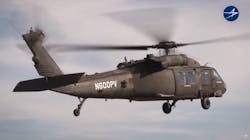Sikorsky and DARPA fly OPV Black Hawk with supervised autonomy
STRATFORD, Conn., - Sikorsky and the U.S. Defense Advanced Research Projects Agency (DARPA) are working to dramatically improve flight safety and operations so humans and machines can work together more seamlessly in the field. Sikorsky is leading the way toward a future where aircraft can be operated with two, one or zero pilots at all times of the day or night and in a variety of complex scenarios, including contested, congested, degraded visual environments (DVE), Lockheed Martin reports. Continue reading original article.
The Intelligent Aerospace take:
March 31, 2021 -“Through the ALIAS program and our unique combination of autonomy software and hardware, we are bringing our customers one step closer to safer and smarter flight,” said Igor Cherepinsky, director of Sikorsky Innovations. “Our end goal is to transition this technology to help address emerging mission requirements, including those outlined in the U.S. Army’s Future Vertical Lift (FVL) program.”
Chief pilot Mark Ward commanded the mission using only a tablet.
“Our approach to autonomy is both full-spectrum and human-centric,” Ward said. “As this demonstration showed, aerial vehicles equipped with MATRIX technology will be capable of operating autonomously from takeoff to landing, something we are capable of doing routinely now.”
Related: Autonomous resupply for US military is flying into reality
Related: Autonomous drones are now delivering defibrillators in Sweden
Jamie Whitney, Associate Editor
Intelligent Aerospace
